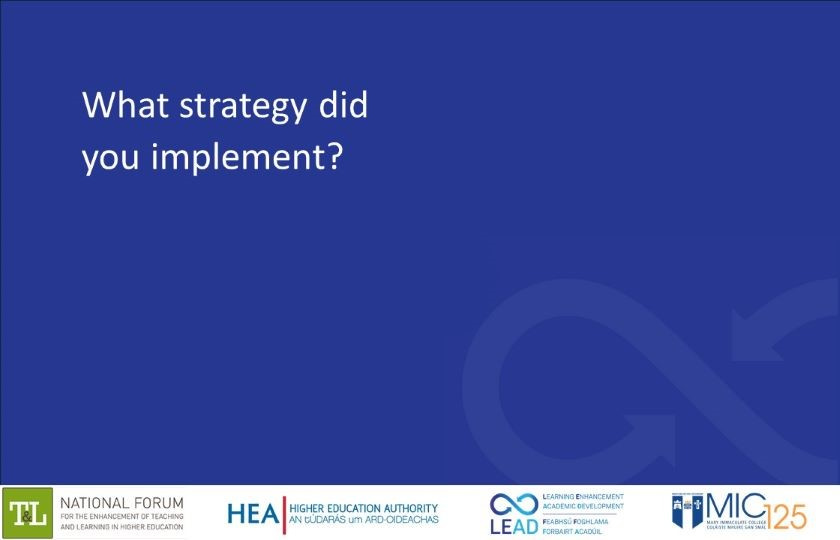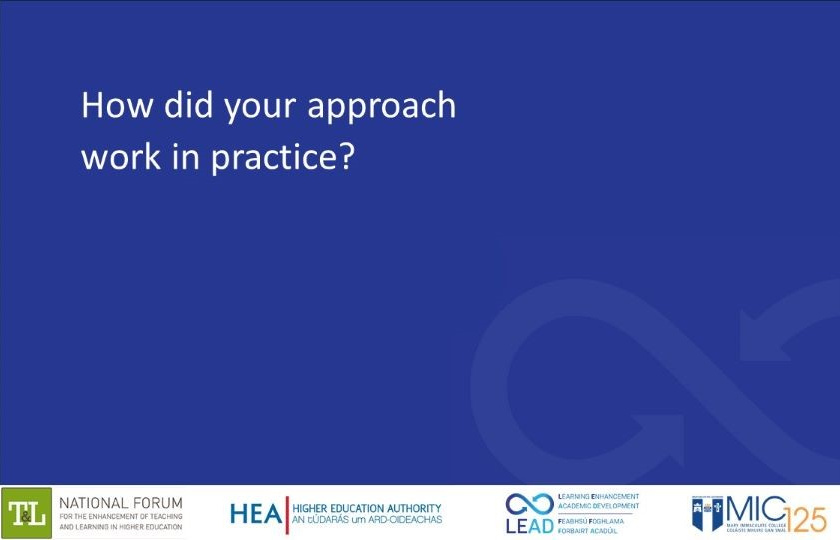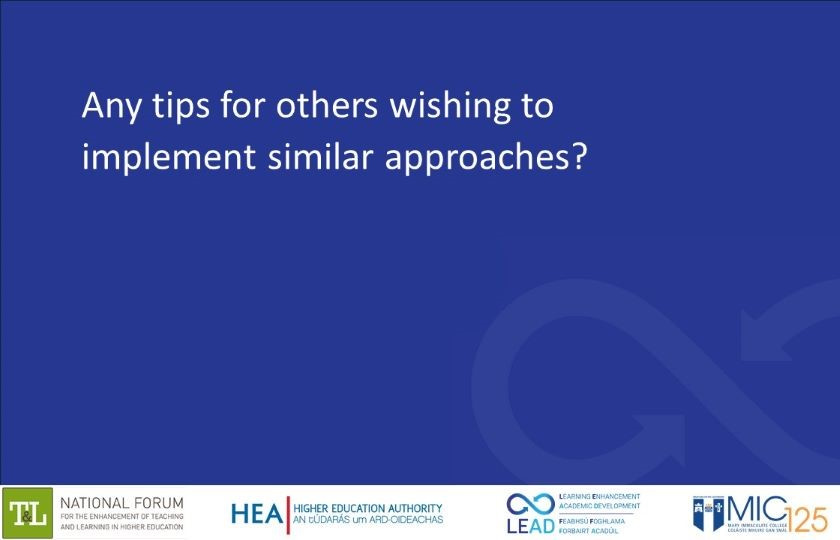Using Student-Generated Video to Assess the Social Psychology of Pro-Environmental Behaviour
Using Student-Generated Video
| Lecturer - Dr Marc Scully |
|---|
| Discipline - Psychology |
| Subject - Applied Social Psychology, a 6-credit module taken as part of both the Bachelor of Education & Psychology and Bachelor of Arts programmes |
| Level - 3rd and 4th Year Undergraduate Students (Level 8) |
| Class Size - circa. 70 students |
| Mode of Delivery - In-person with accompanying VLE |
I sought to design an assessment that would help students to apply social psychological theory and research to contemporary social issues. To facilitate this, I asked students to work in groups of five to produce short videos intended for a general audience. The videos were to outline 'one small way' that viewers could change their behaviour to address the climate crisis, based on the social psychology of behaviour change. To encourage reflective engagement and consolidate the students’ learning, I also asked them to take part in a peer feedback exercise.
Rationale
There were both practical and pedagogical problems with the previous assessments for this module. I was dissatisfied with the mismatch between the learning outcomes, which stressed that students would learn to apply their knowledge, and the academic-oriented ways I assessed this, through a critical review and an essay. In recalibrating my assessments, I wanted students to demonstrate their ability to explain social psychological research to a non-academic audience. I introduced student-generated group videos as a means for students to address a general audience, and I also introduced a separate individual assignment of writing a briefing paper as a means for students to address an audience of policy-makers. Introducing more collaborative and participatory forms of learning also allowed me to align my assessment with the goals of authentic assessment.
On a practical level, marking 70 individual critical reviews during term-time was time-consuming and left me with little time to give the students rich and detailed feedback. Introducing a group project which was amenable to a peer assessment process was a means of addressing this.
Description of the Teaching and Learning Approach

In Week 2 of the Applied Social Psychology module, students have a 2-hour lecture on ‘The Social Psychology of the Climate Crisis and Pro-Environmental Behaviour’. This is followed by a one-hour tutorial, where students work in groups of five to design an environmental initiative based on their learning. They remain in these groups for the video project. Students are tasked with producing a group video for a general audience outlining 'one small way' that viewers can change their behaviour to help the environment and how this is informed by the social psychology of behaviour change. The instructions and rubric for the task are hosted on Moodle for the students, and a guide to preparing a short video and grading rubric is available to download here. Following submission, there is a peer feedback exercise where each student individually assesses and gives feedback on another group’s video using the feedback form available to download here (word file) – the final grade is an average of these assessments appropriately weighted with my own score out of 20.
The use of student-generated video as a means of assessment has burgeoned in the last decade as the requisite technology has become more accessible. Speed et al (2018) argue that student produced videos as a mode of assessment 1) foster the development of critical thinking and creativity, 2) are a format that students are familiar with, and 3) are more applicable to the real-world applied communication of science than the standard long-form laboratory report. Through making the videos, therefore, I hoped to enable students to explore theories and concepts in a practical way, rooting this knowledge in experiences that related to their own lives.
What Worked and Why?

Students engaged enthusiastically with the assessment, producing creative videos on topics such as avoiding ‘fast fashion’, reducing meat consumption, and reducing single-use plastics: all of which were presented in terms more directly relevant to students’ lives than the previous, somewhat dry academic assessments. Feedback from students was largely positive, highlighting the enjoyable novelty of the video project, and its practicality and relevance. In particular, they reported the benefits of the transferable skills they had acquired in science communication, and how the assignment had led them to think in more practical terms about applying social psychological research, leading them to read around the curriculum more broadly than they ordinarily would.
On a practical level, grading and providing feedback for this assignment was less time-consuming than its precursor, while the peer feedback exercise led to greater engagement with the feedback from students.
Any Problems or Issues that Arose from this Approach?
Based on the original roll-out of this assessment in 2021, I have made changes in subsequent deliveries of the module. Firstly, it was evident that my initial guidance to the students, that they should make three-minute-long videos, was too short: I have amended this to four minutes. Secondly, I overestimated the extent to which students, as members of the ‘TikTok generation’, would be naturally familiar with the process of making and editing short videos. As such, I did not sufficiently take into account the diversity of past experience and skills students would bring to the task. Some students became anxious about the process of making the video, to the detriment of the actual content. To address this, I have introduced more scaffolding and greater guidance on the process of making a video (Gillanders et al, 2019). Finally, students reported confusion over the emphasis they should place on the ‘one small change’ itself, vs. how this was underpinned by social psychology. I have since attempted to be clear about this from the outset.
Tips for Implementation

- Be clear about what you want the student-generated video to do, in terms of the learning outcomes. While students are likely to respond to the novelty of the task itself, making it clear how it aligns with the aims of the module will help to foster engagement with class content and will encourage authentic learning.
- Since the aim is to get them using theory in a real-life context, putting emphasis on the value of the content, rather than production values, will help to keep the students focus on the assignment’s aims.
- Introduce the assignment early to give potentially apprehensive students some time to familiarise themselves with the technology they will be using.
- Ensure students have access to video editing software, so that all students can participate equally.
Gillanders, J. et al. (2019) Creating Your Video: A How-To Guide for Student Generated Video, Practitioner Research Project, TU Dublin. https://creatingyourvideo.wordpress.com/
Speed, C. J., Lucarelli, G. A., & Macaulay, J. O. (2018). Student Produced Videos-An Innovative and Creative Approach to Assessment. International Journal of Higher Education, 7(4), 99-109.
Except where otherwise noted, content on the LEAD section of this website is licensed under a Creative Commons Attribution 4.0 International licence.
Guide to Preparing a Short Video
Click here to download a guide to preparing a short video and grading rubric.
In this assignment, you are being asked to work in your groups to prepare a short informational video aimed at the general public on the topic of ‘one small way’ people can change their behaviour to help the environment, and how this is informed by the social psychology of behaviour change. (N.B. the social psychological concepts you are using should be made explicit in the video, rather than left implicit.) The video should be approximately 4 minutes long. There will also be a peer assessment and reflective exercise component to this assignment.
Overall, the assignment is worth 25%. This breaks down as 20% for the video itself, and 5% for the peer assessment exercise. The latter will be assessed on a pass-fail basis.
You should upload the video by 4pm on Wednesday 25 October. One person may upload it on behalf of the group. You can complete the peer assessment exercise at a later date – deadline tbc.
You have a certain level of free choice to decide this in your groups. I would recommend thinking through the following:
- What is the change you will be talking about? Is it a change in purchasing habits, in consumption habits, or in other everyday behaviour? Remember that this should be a relatively low-cost behaviour change – it should be manageable and achievable by the average individual, without too much effort. We’re talking more in the realm of ‘switching to biodegradable tea bags’ or ‘having more meatless days’ than ‘buying an electric car’, or ‘installing solar panels on your house’ here. If you are looking for inspiration, there are a variety of articles online with lists and suggestions of changes to make to everyday behaviour – for instance, this article from SpunOut.ie or the ‘One Change’ series from the Irish Times. This list, 25 ways to save the planet from home, is also from the Irish Times. Alternatively, you could base your ideas around an existing intervention from the social and environmental psychology literature.
- What kind of behavioural change is it, in social psychological terms? How will you link evidence-based social psychological research to this behavioural change? What research findings underpin what you will suggest? This will be where your independent research as a team for relevant published papers will come in.
- How will you best present this in approximately 4 minutes to a general audience?
There is a useful guide here to planning the production aspects of the video.
If you need to borrow a camcorder to make the video, you may do so from the Psychology department. Please contact Michelle Glasheen to arrange collection.
For video editing, you have access to MS Stream via Office 365. You can also access the Windows 10 Video Editor program via any of the computers on campus. There is a how-to guide to using Video Editor here. If you are more experienced with other video editing software, feel free to use that.
Yes
Do we have to appear in the video ourselves?
You have quite a lot of leeway over the actual content of the video so long as you meet the objectives of the assignment. However, bear in mind that there are marks going for creativity.
No. However, you should upload a transcript of the video, and that transcript should include references.
You should upload your finished video to Microsoft Stream via your MIC Office 365 account. When uploading your video, make sure that you set your sharing options so that anyone in MIC can watch the video. You should then email Marc with a link to the video. You should also upload a transcript of the video via the submission link on Moodle. This transcript should include the URL for the video, the names of everyone in your group and what they did, and the references you drew on in making the video.
There are 20 marks for the video. These will be awarded under four criteria (five marks each), as follows:
Creativity: Is the video attractive? Does it make appropriate and imaginative use of the medium? Does it capture and hold the viewer’s attention?
Coherence: Does the video make sense? Does it present a narrative that is easy to follow, without confusion, for the general public?
Evidence-based: Is the video clearly based on social psychological concepts and research on pro-environmental behaviour change?
Applicability: Would the video prove useful to a member of the general public seeking to use social psychological knowledge to live in a more sustainable way?
There is a peer assessment element to this module. Your video will be marked anonymously by some of your classmates, and by me, with a weighted average providing the final mark.
Except where otherwise noted, content on the LEAD section of this website is licensed under a Creative Commons Attribution 4.0 International licence.
Group Video Peer Feedback Component
Click here to download the group video peer feedback form.
You should assess the video using the rubric below. Provide a mark out of 5 for each heading, for a total of 20. You should also include feedback under each heading. This will be anonymised before being collated and returned to the groups. Your feedback should be constructive and avoid personal comment. Please download and complete the group video peer feedback form (Microsoft word), and submit via TurnItIn before 5pm on Friday 10 November.
The scale of marking is as follows:
0 = not included/not attempted, 1 = poor, 2= fair, 3 = good, 4 = excellent, 5 = outstanding/unimprovable.
| Peer Feedback Headings |
|---|
| Creativity: Is the video attractive? Does it make appropriate and imaginative use of the medium? Does it capture and hold the viewer’s attention? |
| Coherence: Does the video make sense? Does it present a narrative that is easy to follow, without confusion, for the general public? |
| Evidence-based: Is the video clearly based on social psychological concepts and research on pro-environmental behaviour change? |
| Applicability: Would the video prove useful to a member of the general public seeking to use social psychological knowledge to live in a more sustainable way? |
Please note:. You need not consider whether the video goes too far over the suggested length and whether points should be deducted accordingly – I will account for that in my final weighting of the marks. You also do not need to consider the transcript in your feedback: but the transcript will be available should you wish to refer to it.
Except where otherwise noted, content on the LEAD section of this website is licensed under a Creative Commons Attribution 4.0 International licence.
- Using Student-Generated Video
- Guide to Preparing a Short Video
- Group Video Peer Feedback Component








